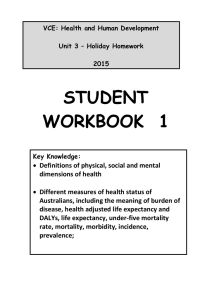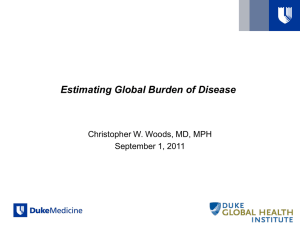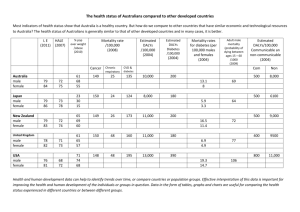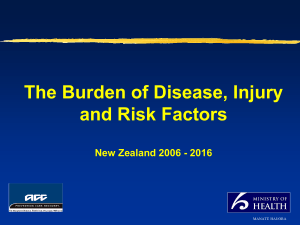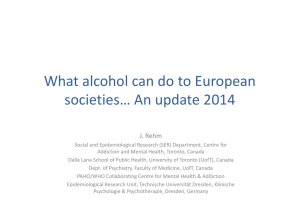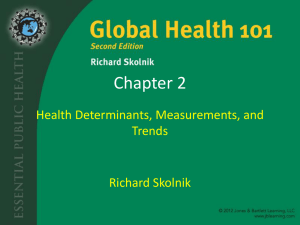1.1 measuring health status_2015
advertisement
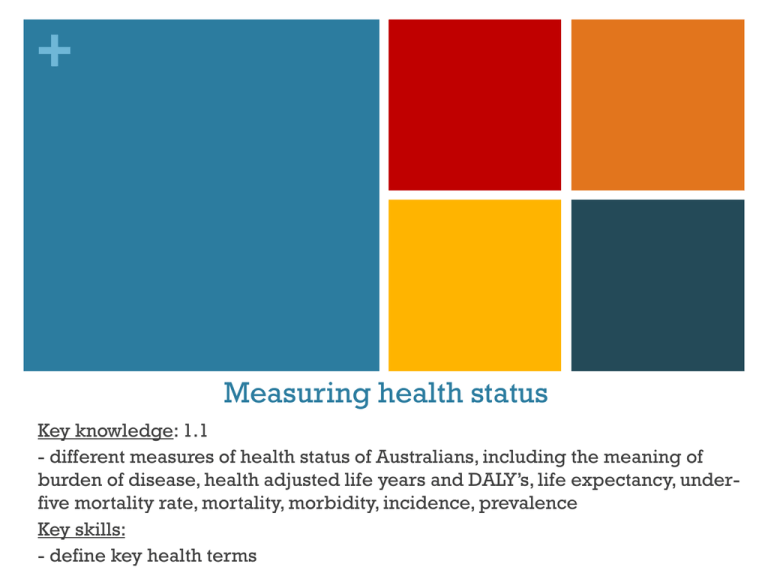
+ Measuring health status Key knowledge: 1.1 - different measures of health status of Australians, including the meaning of burden of disease, health adjusted life years and DALY’s, life expectancy, underfive mortality rate, mortality, morbidity, incidence, prevalence Key skills: - define key health terms + HEALTH How do you know when people are healthy? How do you know when a country or population are healthy? How would you compare Australia to other countries? + HEALTH STATUS An individual’s or population’s overall level of health, taking into account various factors such a life expectancy, amount of disability, and levels of disease risk factors. (VCAA definition) Health status is different to health. HEALTH=PMS HEALTH STATUS= Health Indicators To measure an individuals or populations level of health we need to: Use statistics to be able to make judgements Need to know and understand the health indictors + Why measure health status? Make judgements about the individual/population/groups etc Use information to improve health in the area that needs action Can identify trends which provides feedback on health programs that have already been implemented. + How do we measure health status These terms are all 'Health Indicators'. Life expectancy Burden of Disease •DALY (YLL and YLD) Mortality •Years of life lost HEALTH STATUS Incidence and Prevalence •New Cases and Total Cases Morbidity •Years lived with disability + Life Expectancy An indication of how long a person can expect to live. It is the number of years of life remaining to a person at a particular age if death rates do not change - (VCAA definition) Usually calculated from birth Eg. Life Expectancy ‘At Birth’ – estimates the average number of years a newborn can expect to life if existing mortality patterns continue A baby born in Australia today would expect (approx.) to live more than 80 years of age. Life expectancy can be calculated at other ages (30, 65, 80) + Life Expectancy Describe the changes in life expectancy for males and for females between 1901 and 2005. + Can you see a trend?? + Health Adjusted Life Years (HALE) A measure of burden of disease based on life expectancy at birth, but including an adjustment for time spent in poor health. It is the number of years in full health that a person can expect to life, based on current rates of ill health and mortality- (VCAA definition) An estimate of the number of health years (free from disability or disease) that a person born in a particular year can expect to live, based on current trends in death and disease patterns. EQUATION: HALE = LE – number of years living in unhealthy states + Morbidity Refers to ill health in an individual and the levels of ill health in a population or group- (VCAA definition) Also can be referred in measurements of: Incidence = the number or proportion of new cases of a particular disease or condition present in a population at a given time. Prevalence = the number or proportion of cases of a particular disease or condition present in a population at a given time. + Age-specific prevalence of coronary heart disease, Australia, 2004-05 number of cases of Coronary heart disease in a given time + Number of cases of cancer in young people aged 1214 years between 1993-2002 Cancer incidence in young people aged 12-24 years, 1993-2002: + Mortality Mortality – Refers to deaths in a population. Mortality rate- refers to how many deaths occurred in a population in a given period of time for a specific cases/all causes- (VCAA Definition) Rates are usually presented per 100 000 population in a 12 month period. Mortality data can include: Infant Mortality Rate – refers to the risk of an infant dying between birth and one year of age in a given year per 1000 live births Under-5 Mortality Rate (U5MR) – refers to the number of deaths children under five years of age per 1000 live births Maternal Mortality Ratio – refers to the number of women dying from pregnancy-related causes per 100,000 live births + Identify the similarities and differences between causes of deaths for males and the causes of deaths for females. + What is the trend for the U5MR rate in Australia between 1976 and 2008? What might be some reasons for this trend?? + Burden of disease A measure of the impact of diseases and injuries, specifically it measures the gap between current health status and an ideal situation where everyone lives to an old age free of disease and disability. Burden of disease is measured in a unit called the DALY- (VCAA definition) Combines mortality and morbidity E.g enables us to measure impact of cancer (that causes mortality) and asthma (which causes morbidity) + Measurement of Burden of Disease DALY= A measurement of burden of disease, one DALY equals one year of healthy life lost due to premature death and time lived with illness or disease- (VCAA definition) 1 DALY is one year of ‘healthy life’ lost due to a disease or injury + Burden of Disease Which diseases were the two leading causes of burden of disease in Australia in 2003? For these two diseases were there more DALYs due to death or more DALYs due to disability? Identify the number of DALYs for each of the fatal component (YLL) and the nonfatal component (YLD) for injuries. + Years of life lost - YLL Years of life lost to premature mortality/death; Dying before it was predicted that you would. What can be concluded from the data below in regard to males a females? Total Number of years lost in 1996 + Years lost due to disability YLD What are the top 3 YLD for major disease groups in 1996? How many YLD occurred in 1996 for these diseases? + + BUT...... EVERY TIME WE ARE SICK OR WE DIE WE GET FURTHER AWAY FROM BEING FREE FROM DISEASE WE WANT TO BE HERE The bigger the gap, the more DALYS (YLD + YLL) AND ILLNESS AND THE GAP GETS BIGGER AND BIGGER.... IMPACT IMPACT CVD IMPACT IMPACT Cancer Asthma back pain Gap starts to grow Optimal Health - Old age and free of disease/illness and grow and grow and grow...... + Disability Adjusted Life Years YLL=one YLL equals one year of life lost due to premature death (fatal). YLD= one YLD equals one year of life lost to illness or injury (non fatal). Various conditions have a different impact/burden on health status. The way this is calculated is measured through a complex formula as all conditions vary in severity. E.g arthritis may have a greater impact on someone's life compared to mild asthma. ACTIVITIES - Practice exam questions in booklet - Read pages 10-28 - Answer questions: Page 12: 3 Page 17: 2,3,4,5, 6,7 Page 22: 3, 4, 5, 6, 7, 9, 13 Page 28: 4, 5, 6 - Learn all key terms and be able to define them by the first week back in 2014 -eLesson and study on activities + + Answer + Practice Exam Questions Define life expectancy ___________________________________________________________________ ___________________________________________________________________ ___________________________________________________________________ 2 marks (VCAA HHD exam 2009) + Answer + Practice Exam Questions Briefly outline two indicators that are used to measure the health status of populations. 1. ____________________________________________________________ ____________________________________________________________ ____________________________________________________________ 2. ____________________________________________________________ ____________________________________________________________ ____________________________________________________________ 4 marks + Answer + Practice Exam Questions Jeanette has been diagnosed with the early symptoms of Diabetes Mellitus Type II. She lives in the City of Moonee Valley and has been asked by the health promotion Council to be involved in the ‘Life’ program. Diabetes Australia Vic. Has been ranked the City of Moonee Valley 57th in Victoria for the number of cases of Diabetes Mellitus. Although not considered a ‘hot spot’ it has had an increase of 94% in the prevalence of Diabetes in its population. Define prevalence. _____________________________________________________________ _____________________________________________________________ 1 mark + Answer

